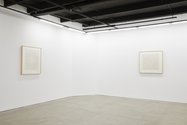John Hurrell – 2 March, 2020
Examining the drawings, the main theme seems to be that of overlapping planes or telescopically inserted cylinders of netting. Sydow is fascinated by the shimmering confusion resulting from complex grids optically merging when one is placed over the other. The moiré effect is often used, in the sculptures featuring metal sheets of punched out gridded holes, suspended on steel frames with springs so that they both physically and optically tremble when the moving viewer looks through them.
In a show that is rare for Auckland, Bowerbank Ninow present seven framed drawings by the seventies Christchurch sculptor Carl Sydow; a mixture of preparatory geometric studies for three dimensional works, and images planned as final pieces to be enjoyed for their overlapping grid structures and optical effects.
Even though he was a sculptor who made drawings, Sydow’s practice can be seen as related to the paintings of François Morellet in France, Gianfranco Zappettino in Italy, and Al Held and Richard Anuszkiewicz in the States. And Ray Thorburn in Aotearoa. In other words Sydow (1940 -1975) was a typical seventies internationalist in his stylistic and conceptual enthusiasms, commonplace at the time (but rarely seen now)—before geometric abstraction and hard edges got swept aside in the eighties by the gesturally inflected narratives of Neo-Expressionism and the Transavangardia.
Using industrial construction-site materials, Sydow (a contemporary of John Panting and Steven Furlonger ) made several types of constructivist-influenced sculpture that explored overlapping grids, optics, transparency, suspension, chance and viewer movement. All designed for outdoors and an urban space where they interacted with modernist architecture.
Examining these drawings, the main theme seems to be that of overlapping planes or telescopically inserted cylinders of netting. Sydow is fascinated by the shimmering confusion resulting from complex grids optically merging when one is placed over the other. The moiré effect is often used, particularly in the sculptures featuring metal sheets of punched out gridded holes, suspended on steel frames with springs (at the corners) so that they both physically and optically tremble when the moving viewer approaches and looks through them.
Other images seem to be repeated slings for holding suspended forms or coloured rectangular planes, or prisms and house shapes stacked up en masse (sometimes inverted). Most drawings employ the conventions of perspective, though one preparatory drawing is orthogonal.
It would be terrific to someday get a bunch of Sydow‘s unusual sculptures displayed in Auckland. They are extraordinarily individualistic, with their use of transparent Perspex, corrugated iron sheeting, looping garden hose, mesh, and steel armatures. Exciting and radically distinctive.
John Hurrell











 Two Rooms presents a program of residencies and projects
Two Rooms presents a program of residencies and projects Advertising in this column
Advertising in this column



This Discussion has 0 comments.
Comment
Participate
Register to Participate.
Sign in
Sign in to an existing account.